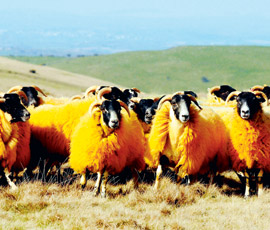High-tech ways to beat rustlers

Sheep and cattle rustling has reached new heights during the last year. Andy Collings looks at what preventative measures can be taken
High meat prices has resulted in some thieves turning their attention away from their traditional targets – farm machinery, workshop equipment and fuel – to rustling cattle and sheep.
The last 12 months have seen numbers of stolen animals reach frightening proportions. Some 67,000 sheep were stolen in 2011 at a cost to farmers of over £6m.
And it’s not just sheep which are being stolen – thieves are also taking cattle, pigs and even game birds.
According to NFU Mutual’s rural affairs spokesman, Tim Price, thefts of sheep and cattle have increased four-fold in just 12 months and insurance claims have risen by 170%.
“Higher meat prices appear to be leading to a resurgence in livestock rustling,” he says. “There is a close correlation between the price of commodities and the level of thefts.”
Mr Price says he believes the majority of stolen livestock go straight into the food chain which brings the risk that they may be slaughtered, butchered and stored in unhygienic conditions.
What’s the answer?
But what can be done by producers to prevent their livestock from being stolen? The truth is that preventing rustling is not easy – you can’t lock livestock up for the night and you can’t fit immobilisers to them.
Cattle and sheep are normally out in fields for a good part of the year, fields which may be several miles away from civilisation. A deserted country lane, a five-bar gate and a few strands of barbed wire pose few problems for thieves intent on loading up a lorry load of cattle.
Investing in CCTV, movement detectors or other detection devices could be prohibitively expensive as would employing someone to maintain a watchful eye on them during the small hours.
The NFU Mutual’s advice is to:
• Padlock field gates
• Ensure stock is clearly marked and records are up to date
• Graze sheep in fields away from roads when possible
• Check stock regularly and vary feeding times
• Ask neighbours to report sightings of unusual vehicles loading sheep
• Join a FarmWatch scheme
All of which makes good sense but sadly, does not add up to a mountain of security or a good night’s sleep for a producer whose lambs are just about ready for market.
Farmer suggestions have included applying powdered limestone to field gateways to provide a white mark for lorries and footwear and even dipping sheep in an orange dye to deter thieves from targeting the flock, which will probably work well unless the whole county latches on to the same idea.
High-tech solutions – DNA database
Interestingly, an increase in rustling has also caught the attention of Israeli company Bactochem. This company, which works in microbiological and chemical testing of food and has developed what is claimed to be the world’s largest DNA database for cattle.
Using the database, police can determine from where a cattle rustler stole an animal and make the appropriate arrests. The system acquires its DNA data by requiring a farmer to send genetic samples from newborn calves to Bactochem’s laboratories where it is analysed and the results added to the database along with details of where and when etc.
DNA can be used to assign calves to their individual sires so that paternity identification can be achieved – further help for the police in their investigations.
The DNA data can also be used to provide precise traceability for meat. Encoded with a security code, the DNA data is placed in a barcode which is then attached to all the meat joints from each specific animal so that, even in a supermarket, the meat can be traced back to a specific animal and its owner.
High-tech solutions – retinal imaging
This offers the ability to identify an animal through its unique blood vessel pattern on the retina. This pattern is fixed at birth and does not change throughout its lifetime – nor does it for humans.
Pioneered by a US company called Optibrand, a digital camera is used to capture an image and combines it with an encrypted position, date and time using GPS. This all makes for a unique data entry for a specific animal which could be used by the authorities to trace its owner should it be stolen.
Unlike the DNA system, though, once the animals have been slaughtered and the head removed traceability becomes impossible.

